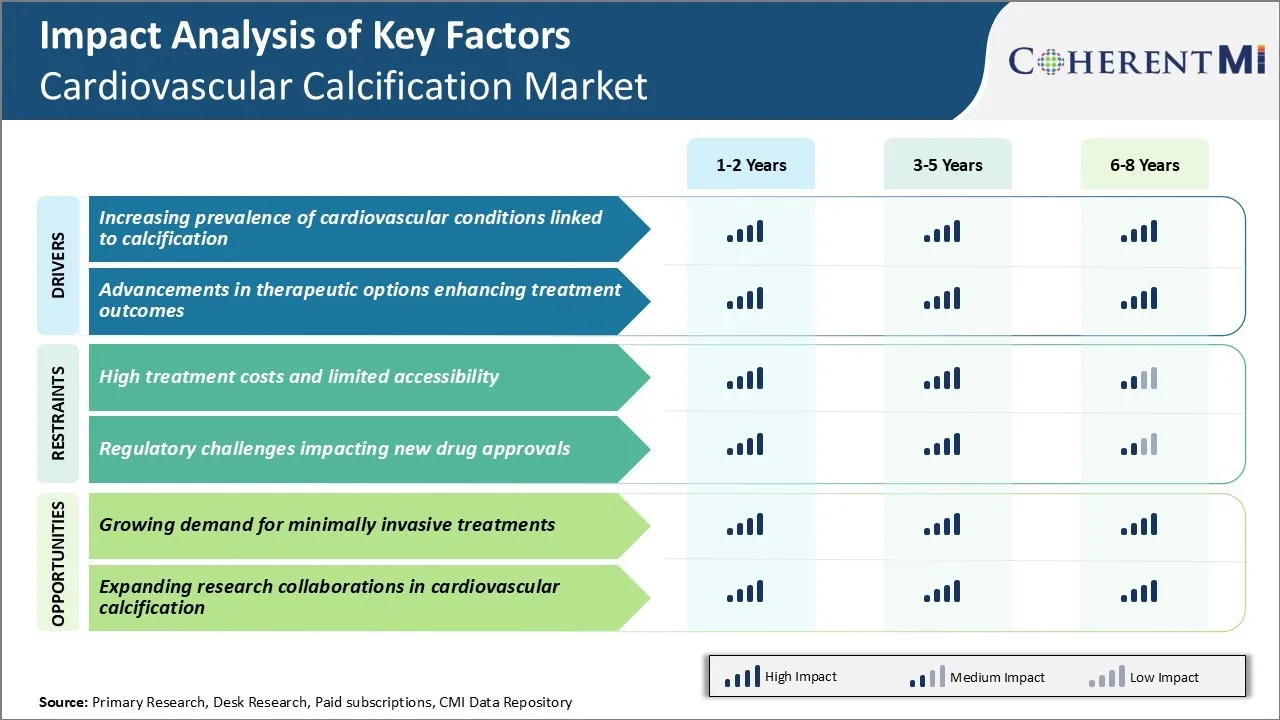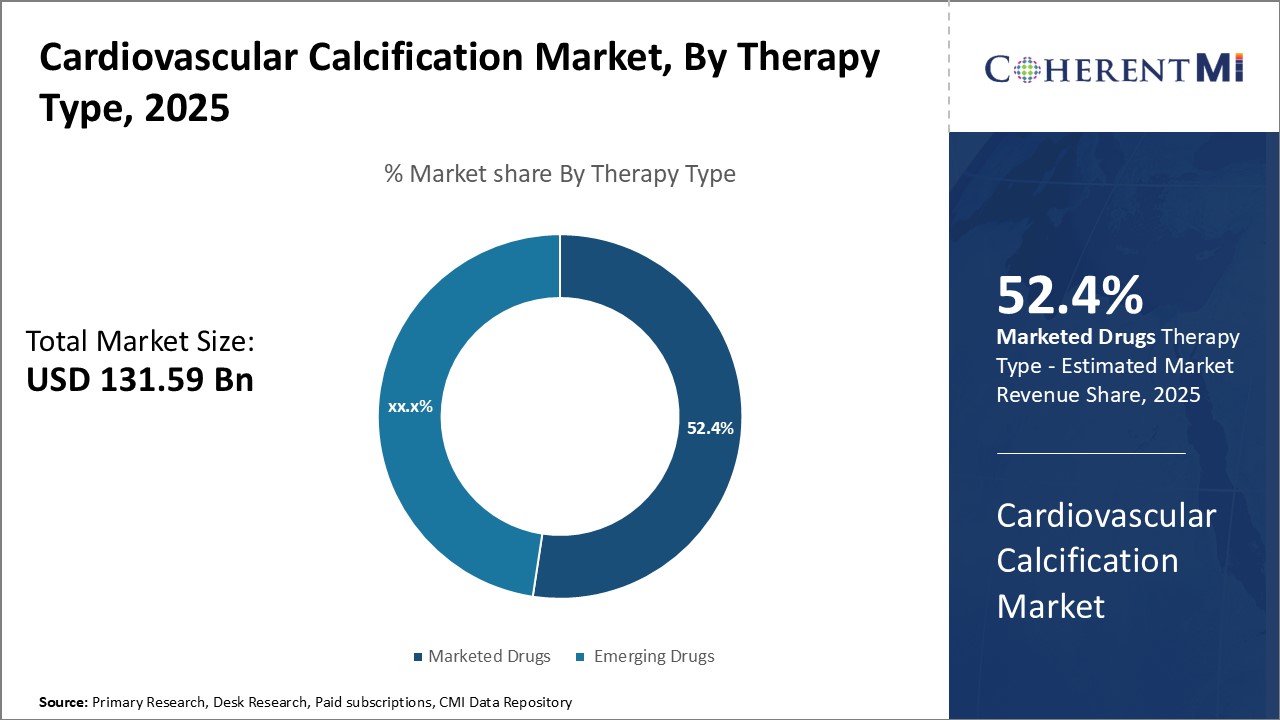Cardiovascular Calcification Market Size - Analysis
The cardiovascular calcification market is estimated to be valued at USD 131.59 billion in 2025 and is expected to reach USD 186.40 billion by 2032, growing at a compound annual growth rate (CAGR) of 5.1% from 2025 to 2032.
Market Size in USD Bn
CAGR5.1%
| Study Period | 2025-2032 |
| Base Year of Estimation | 2024 |
| CAGR | 5.1% |
| Market Concentration | High |
| Major Players | Sanifit, Inositec, Sanofi, Dong-A ST and Among Others |
please let us know !
Cardiovascular Calcification Market Trends
The increasing prevalence of cardiovascular conditions that are linked with calcification poses a major driver for the growth of the cardiovascular calcification market. Various lifestyle changes such as unhealthy diet, lack of physical activity, smoking and high levels of stress have significantly contributed to the rising incidence of cardiovascular diseases over the past few decades. According to studies, cardiovascular diseases have become one of the leading causes of mortality worldwide. Many CV conditions involve calcification of the arteries and heart valves over time which can limit blood flow and greatly impact heart function if left untreated.
Considerable efforts are being made by companies to develop more effective therapeutic solutions that can aid in halting or reversing the progression of calcification. Some of the latest approaches gaining interest include calcium-chelating agents, sodium thiosulfate, bisphosphonates and localized drug-delivery therapies. These treatments work by removing excess calcium from tissues using chemical bonding or altering cellular activity and mineralization pathways involved in the calcification process.
With persistent R&D focus on decalcifying strategies, availability of superior monitoring and localized treatment options are positively impacting outlook. They offer physicians and patients an advantage in slowing, stopping or possibly reversing the formation of hard, calcium stones in cardiovascular structures. This expands the choice of minimally invasive treatments and supports better management of chronic cardiac problems linked to calcification. Ultimately, it is the development of superior solutions for combating calcification at various stages that will drive adoption and growth prospects for participants in this specialized field.

One of the key challenges facing the cardiovascular calcification market is the high costs associated with treating cardiovascular conditions. Developing new treatments and therapies to help manage cardiovascular calcification often requires extensive research and clinical trials. This results in high development costs for pharmaceutical and device companies.
The high costs of treatments like cardiovascular stents and angioplasty procedures remain out of reach for large populations globally. Increased research into more cost-effective therapies could help address this challenge and expand access to needed care.
Market Opportunity - Growing Demand for Minimally Invasive Treatments
Minimally invasive techniques like Transcatheter Aortic Valve Replacement (TAVR) are becoming increasingly popular alternatives to open-heart surgery, as they offer substantial benefits in terms of reduced surgical risks, scarring, and pain for patients. Advancements in areas like catheter-based excimer laser angioplasty also enable clearing of calcified arteries using small catheter devices inserted via small incisions rather than open vascular surgery.
Prescribers preferences of Cardiovascular Calcification Market
Cardiovascular calcification is a progressive disease that is often treated through multiple lines of therapy. In early stages, lifestyle modifications such as exercise, diet changes, and smoking cessation are typically recommended. Prescribers may also prescribe cholesterol-lowering medications such as statins. Common statin drugs prescribed include Atorvastatin (Lipitor), Rosuvastatin (Crestor), and Simvastatin (Zocor).
For severe, advanced cases, novel anticalcific therapies are gaining traction. These target underlying biologic mechanisms driving calcification. Promising new agents inhibiting proteins like Matrix Gla Protein (MGP) are in late-stage trials. If approved, such specialized treatments like Elinogrel (formerly AZD1656) may reshape the standard of care algorithm, featuring as later line options.
Treatment Option Analysis of Cardiovascular Calcification Market
Cardiovascular calcification occurs in multiple stages with increasing calcium deposition in the arteries over time. The treatment approach varies depending on the stage of the disease.
Moderate calcification is often treated with oral medications in addition to lifestyle changes. Common choices include bisphosphonates like alendronate which inhibit bone resorption and calcium deposition. Cardioprotective drugs like ranolazine help reduce chest pain.
The choice of treatment depends on individual risk factors, comorbidities, and stage of disease. A multidrug regime combined with lifestyle modifications offers the best approach to delay cardiovascular complications from calcification long-term.
Key winning strategies adopted by key players of Cardiovascular Calcification Market
Product innovation: One of the most successful strategies adopted by major players like Medtronic and Edwards Lifesciences has been continuous investment in R&D to develop innovative products. For example, in 2018 Medtronic launched the CoreValve Evolut PRO aortic valve system with superior hemodynamics compared to previous versions, helping expand its market share.
Geographic expansion: Players like Abbott have increased their presence in high-growth emerging markets like China, India and Latin America through strategic investments and partnerships. For example, Abbott invested $100 million in 2020 to expand its manufacturing plants in India.
Segmental Analysis of Cardiovascular Calcification Market
The marketed drugs segment contributes the highest share to the cardiovascular calcification market due to the established safety and efficacy of these therapies. Drugs that fall under this segment have already received regulatory approval after going through extensive clinical testing. Their long-term usage and large patient base have allowed physicians to better understand treatment outcomes and side effect profiles. This translates to confidence in prescription among doctors for patients diagnosed with cardiovascular calcification. Additionally, many of these drugs have been available for decades and have a well-established set of guidelines regarding their clinical use. This facilitates their integration into standard treatment pathways.

Competitive overview of Cardiovascular Calcification Market
The major players operating in the Cardiovascular Calcification Market include Sanifit, Inositec, Sanofi, and Dong-A ST.
Cardiovascular Calcification Market Leaders
- Sanifit
- Inositec
- Sanofi
- Dong-A ST
Cardiovascular Calcification Market - Competitive Rivalry

Cardiovascular Calcification Market
(Dominated by major players)
(Highly competitive with lots of players.)
Recent Developments in Cardiovascular Calcification Market
- In January 2023, Sanifit - a Spanish biopharmaceutical company - announced that it has intensified its focus on developing novel calcification inhibitors in late-stage trials. Their lead compound, SNF472, is a novel calcification inhibitor aimed at treating cardiovascular calcification in patients with end-stage renal disease (ESRD) undergoing hemodialysis. As of January 2023, SNF472 was in late-stage clinical trials (specifically Phase III trials). The drug has shown promise in reducing the progression of cardiovascular calcification, which is a significant risk factor for cardiovascular morbidity.
- In March 2023, Inositec - a Swiss biotech company - make announcements about progressed Phase II trials of their lead candidate targeting vascular calcification. Their lead candidate, often referred to in earlier stages as INS-3001, was primarily in preclinical or early clinical development stages.
Cardiovascular Calcification Market Segmentation
- By Therapy Type
- Marketed Drugs
- Emerging Drugs

Would you like to explore the option of buying individual sections of this report?
Vipul Patil is a dynamic management consultant with 6 years of dedicated experience in the pharmaceutical industry. Known for his analytical acumen and strategic insight, Vipul has successfully partnered with pharmaceutical companies to enhance operational efficiency, cross broader expansion, and navigate the complexities of distribution in markets with high revenue potential.
Frequently Asked Questions :
How big is the cardiovascular calcification market?
The cardiovascular calcification market is estimated to be valued at USD 131.59 billion in 2025 and is expected to reach USD 186.40 billion by 2032.
What are the key factors hampering the growth of the cardiovascular calcification market?
The high treatment costs and limited accessibility and regulatory challenges impacting new drug approvals are the major factors hampering the growth of the cardiovascular calcification market.
What are the major factors driving the cardiovascular calcification market growth?
The increasing prevalence of cardiovascular conditions linked to calcification and advancements in therapeutic options enhancing treatment outcomes are the major factors driving the cardiovascular calcification market.
Which is the leading therapy type in the cardiovascular calcification market?
The leading therapy type segment is marketed drugs.
Which are the major players operating in the cardiovascular calcification market?
Sanifit, Inositec, Sanofi, and Dong-A ST are the major players.
What will be the CAGR of the cardiovascular calcification market?
The CAGR of the cardiovascular calcification market is projected to be 5.1% from 2025-2032.